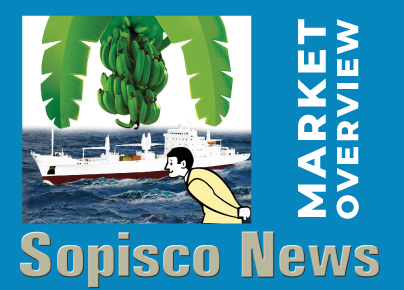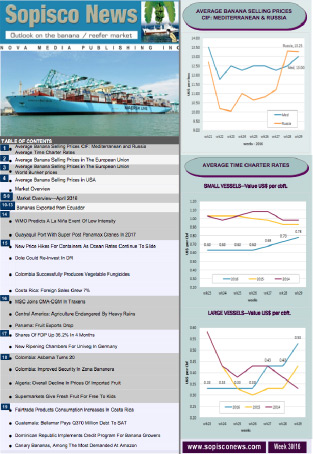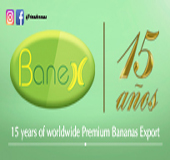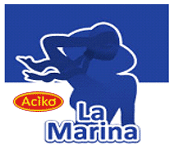Market Overview – Week 10 / 2024
2024-03-08

In St. Petersburg, banana selling prices fluctuated between USD 17.25 and USD 19.45 per box CIF. The price variation was contingent upon factors such as the brand, quality, volume, and type of packaging. Sales didn’t improve compared to the previous week. This stagnation in sales can be attributed to a need for stronger market demand.
During week 10, approximately 1.35 million boxes of bananas were discharged, and around 2.02 million boxes are anticipated to be discharged in the 11th week.
The prevailing exchange rate was 1 USD = 90.75 RUB during this period.
In the Mediterranean market, Ecuadorian banana prices ranged from USD 17.00 to USD 18.00 per box CIF. These prices were influenced by various factors such as brand, region, volume, and packing. In contrast, Central American fruit was sold at a lower price, around USD 2.00 less per carton.
In the Mersin Free Zone, re-exported bananas of Ecuadorian origin were priced between USD 17.00 and 18.50 per box. On certain occasions, the prices of extra-quality and heavy-weight boxes even reached USD 19.00 per box. Meanwhile, bananas from Central America were quoted at USD 13.50-15.50 per box.
The exchange rate was 1 USD=31.96 TL. The Turkish Lira experienced a further decline against the USD. The currency weakened by 0.2 per cent to 31.9536 per US dollar, extending its losses for that week to 1.9 per cent.
Several factors contributed to this decline. The inflation rate for February was announced as 67.1 per cent year-on-year, which was higher than expected. This higher inflation rate exerted additional pressure on the currency. Furthermore, concerns about the decline in foreign reserves also weighed on the currency.
In response to these challenges, the Turkish central bank implemented additional tightening measures, including a temporary cap on credit growth, to stabilize the currency.
In the Iranian domestic market, banana prices have been increasing, reaching high levels due to robust demand. This surge in demand is primarily in anticipation of Nowruz, the Persian New Year, which falls on March 20.
Ecuadorian bananas have been selling at around 80.000-90.000 Toman per kg across various cities. In contrast, Indian bananas have been priced slightly lower, around 69,000-73,000 Toman per kg.
Operations at the Iran-Turkey border were slow. There has been congestion at Jebel Ali, one of the hub ports for shipments to Iran. Similarly, operations at Bandar Abbas, where Indian bananas are mainly discharged, have been sluggish. Indian banana prices remain high, hovering around USD 10.75-11.00 CIF Bandar Abbas for the 13.50 kg box. The exchange rate during this period was 1 USD=60.000-61.000 Toman; the further devaluation of the Iranian currency might hinder the future import of bananas, according to local traders.
Among the reasons for the devaluation of the Toman are :
Economic Crisis, Iran’s economy has been in crisis, with inflation fluctuating between 39 and 56 per cent during the first nine months of 2023. This economic instability has contributed to the devaluation of the Toman.
Political Challenges, the Iranian government has grappled with political stability and economic issues. The legitimacy of the regime has eroded, especially after the brutal crackdown on nationwide demonstrations in 2022.
Sanctions and Global Relations, harsh US sanctions have battered Iran’s economy, leading to a steady decline in the value of the Toman. Tensions between Iran, the United States, and Israel have also affected the currency’s devaluation.
Reliance on Oil Revenues, Iran’s budget deficit and reliance on oil export revenues, an unstable source, have also contributed to the currency’s devaluation. These factors combined have led to the further devaluation of the Iranian Toman.
Banana prices in the Ecuadorian Spot Market were around USD 6.85-7.50 per box for the fruit. They dropped compared to the past week as higher volumes of fruit were available and lower demand.
Regarding the chartering market during the week, no fixtures were reported in the banana trade.
Several large vessels are reportedly actively engaged in the fish trade sector. These vessels primarily operate from Alaska, with their cargo destined for various locations in Asia and Europe. Additionally, at least 8-10 vessels are in the Southern Atlantic for the squid campaign. On the other hand, smaller tonnage vessels are predominantly employed in the intra-African fish trade and transporting cargo from various loading ports to West Africa.
In the fruit trade, one more vessel is anticipated to load deciduous fruit in South Africa. However, many ships are loading deciduous fruit in Argentina, with Russia being the primary destination. Furthermore, Kiwi shipments from New Zealand to Asia and Europe will commence shortly.
Regarding Time Charter (T/C) rates, larger vessels have reached a rate of 90-95 US Cents per cubic foot (cbft) per month, projected to rise further. Meanwhile, the T/C rates for smaller tonnage vessels hover around 85-90 US Cents per cbft per month.
Bunker Prices:
VLSFO MGO
Rotterdam $585.50 $796.50
Gibraltar $623.00 $844.00
Panama $601.00 -









